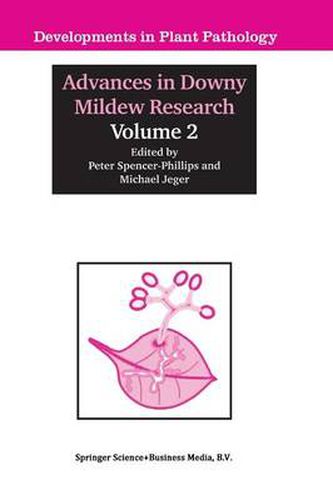Readings Newsletter
Become a Readings Member to make your shopping experience even easier.
Sign in or sign up for free!
You’re not far away from qualifying for FREE standard shipping within Australia
You’ve qualified for FREE standard shipping within Australia
The cart is loading…






This title is printed to order. This book may have been self-published. If so, we cannot guarantee the quality of the content. In the main most books will have gone through the editing process however some may not. We therefore suggest that you be aware of this before ordering this book. If in doubt check either the author or publisher’s details as we are unable to accept any returns unless they are faulty. Please contact us if you have any questions.
Emphasis in this second volume of Advances in Downy Mildew Research is on the biology of compatible interactions, forecasting and epidemiology, host specialisation, genetic variability amongst pathogen populations, novel methods for detection and systematics, and induced resistance. Two chapters focus on the related oomycete Albugo candida, which shares many pathogenic characteristics with the downy mildews and provides a valuable comparative pathosystem. Contributions on specific downy mildews include Bremia lactucae, Peronospora destructor, Peronospora sparsa, Peronospora viciae, Plasmopara halstedii, Plasmopara viticola, Pseudoperonospora cubensis and Sclerospora graminicola. Review chapters on compatibility, forecasting and systematics consider a broader range of downy mildew fungi, and compare them with other oomycete and biotrophic pathogens. The book is relevant to anyone with an interest in these unique biotrophic pathogens, either in their own right as causes of damaging diseases or as model systems for research on host-pathogen interactions. It should be read by: students, teachers and researchers in academic and research institutes; research and development personnel in the agrochemical industries; agricultural and horticultural advisers, and other extension workers.
$9.00 standard shipping within Australia
FREE standard shipping within Australia for orders over $100.00
Express & International shipping calculated at checkout
This title is printed to order. This book may have been self-published. If so, we cannot guarantee the quality of the content. In the main most books will have gone through the editing process however some may not. We therefore suggest that you be aware of this before ordering this book. If in doubt check either the author or publisher’s details as we are unable to accept any returns unless they are faulty. Please contact us if you have any questions.
Emphasis in this second volume of Advances in Downy Mildew Research is on the biology of compatible interactions, forecasting and epidemiology, host specialisation, genetic variability amongst pathogen populations, novel methods for detection and systematics, and induced resistance. Two chapters focus on the related oomycete Albugo candida, which shares many pathogenic characteristics with the downy mildews and provides a valuable comparative pathosystem. Contributions on specific downy mildews include Bremia lactucae, Peronospora destructor, Peronospora sparsa, Peronospora viciae, Plasmopara halstedii, Plasmopara viticola, Pseudoperonospora cubensis and Sclerospora graminicola. Review chapters on compatibility, forecasting and systematics consider a broader range of downy mildew fungi, and compare them with other oomycete and biotrophic pathogens. The book is relevant to anyone with an interest in these unique biotrophic pathogens, either in their own right as causes of damaging diseases or as model systems for research on host-pathogen interactions. It should be read by: students, teachers and researchers in academic and research institutes; research and development personnel in the agrochemical industries; agricultural and horticultural advisers, and other extension workers.